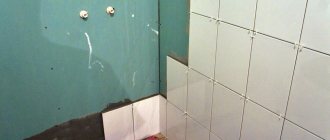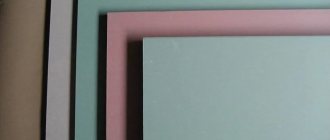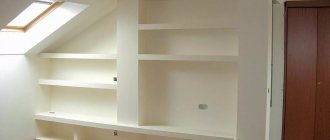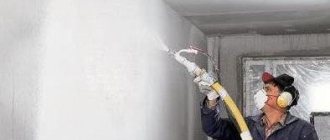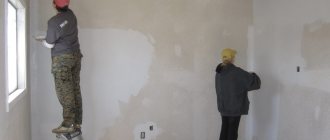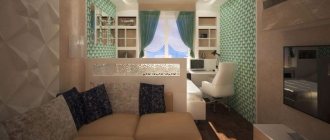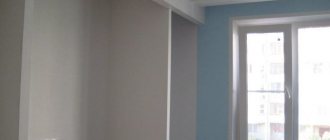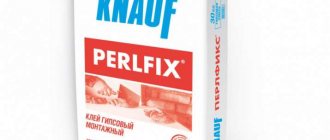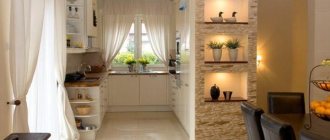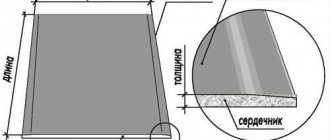Installation of cardboard
Fundamentally, the installation technology does not differ from standard or moisture-resistant drywall, it is simply somewhat complicated by the high rigidity of the coating. For installation, a reinforced guide profile is used, which can withstand higher loads than the standard one.
Photo - editing
Step-by-step instructions on how to install fireproof drywall:
The first stage is preparing the walls. They are stripped of the old coating and treated with priming and, if necessary, leveling compounds.
Please note that many professional builders also recommend additionally covering the walls with fire-resistant substances, which will help increase the fire safety of the home; Next, mark the installation location of the cardboard. The profile is mounted at a distance of 10 cm from the ceiling, and up to 5 cm from the floor (depending on the type of frame)
It is secured with elongated dowels; Direct installation of drywall is also carried out using special fasteners. They must be made of fire-resistant material (alloy steel) and have high torsional resistance. This will increase the rigidity of the support system.
The finishing process is carried out in the same way as for other sheets - the surface is primed with a special primer, after which the seams and slopes are rubbed down.
You can buy fire-resistant plasterboard in any city in Russia and the CIS countries; the price of the coating may vary depending on the brand and size of the sheets. Construction materials from Knauf, which are additionally processed with resistant compounds, are considered to be of the highest quality. Cost 12.5*1200*2500 Knauf:
What ensures fire-resistant qualities?
The gypsum core with glass fibers does not require special treatment. The inorganic base has natural fire-resistant properties, which are enhanced by special firing of the gypsum mass.
Cardboard cladding is impregnated with fire retardants to increase fire resistance. The entire plasterboard board is thoroughly pressed. The presence of air bubbles between layers is excluded. As a result, fire-resistant plasterboard has improved fire-resistant characteristics.
The absence of air layers prevents the product from being easily flammable. A standard fireproof sheet can withstand 20 minutes of exposure to an open flame.
Select manufacturers produce products with increased fire resistance. The fire resistance limit of plasterboard is increased by an additional inner layer of clay. Depending on the composition of the clay mass and the thickness of the layer, the fire-resistant properties may vary.
Manufacturer's choice
Types and characteristics of fire barriers
The plasterboard of the German brand Knauf is considered the most resistant to fire due to the surface impregnated with a special fire-resistant compound. The fire resistance limit of Knauf plasterboard is 60 minutes, after which destruction begins. Characteristics of Knauf heat-resistant plasterboard include the fact that it does not conduct electric current in the event of heavy water flooding from neighbors above or leaking water pipes.
Knauf fire-resistant plasterboard has the character of environmental safety, water resistance, and fire resistance properties. Fireproof plasterboard is used:
- for fireplace
- suspended ceilings
- partitions in private houses
- in high-traffic public places
- in schools, childcare centers
The product is the most in demand on the market, 2/3 of gypsum plasterboards are sold with the Knauf trademark.
in Volgograd produces fire-resistant plasterboard with a high degree of fire resistance - 45-50 minutes. The material costs a little less than imported analogues.
The beveled edge of heat-resistant boards with a line applied by the Rigips company (Rigips) facilitates the marking and installation of fire-resistant sheets.
from the city of Saransk supplies fire-resistant plasterboard with increased strength and flexibility. Heat-resistant plasterboard has high class A characteristics, environmental safety and high dimensional accuracy and a refined edge. The fire resistance limit of Magma plasterboard is 45 minutes after the start of ignition. Fire retardant blocks are available in pink and gray colors.
They cover schools, walls, ceilings of children's rooms, fire-hazardous fireplaces, and combustible bases with fireproof plasterboard.
Comparative table of prices for fire-resistant plasterboard brands on the Russian trade market.
Brand name | A country | Specifications | Dimensions (mm) | Price of 1 sheet in rubles. | Fire rating (minutes) |
| Knauf | Germany | GKLO | 2500x1200x12.5 | 380 — 470 | 60 |
| GYPROC | Scandinavian countries | GKLO | 2500x1200x12.5 | 365 — 403 | |
| NORGIPS | Poland | GKLO | 12.5x1200x2600 | 310 | |
| Belgyps. | Belarus | GKLVO | 12.5x1200x3000 | 304 | 45 |
| GIFAS (Gifas) | Russia, Sverdlovsk plant | GKLO | 12.5x2500x1200 | 346 | |
| Volma | Russia, Volgograd | GKLO | 2.5x1.2m x 12.5 | 306 | 45 |
| Rigips (Rigips) | France, Compagnie de Saint-Gobain SA | GKLO | 12.5x1.2x3.0m | 372 | |
| Giproc | GKLO | 12.5x1200x2500 | 337 | ||
| Magma | Russia, Saransk | GKLO | 2500x1200x12.5 | 311 | 45 |
As can be seen from the table, the difference in prices is insignificant. More expensive are the imported analogues Knauf, GYPROC, Rigips.
Does drywall burn?
To answer this question, it is necessary to analyze the composition of standard gypsum board sheets:
- The base is pressed gypsum with mineral or polymer additives responsible for certain qualities. This layer will not burn even with a constant flame, but the temperature effect disrupts the structure of the slab, which leads to a loss of strength.
- The outer layer of both sides is cardboard. The material is not heat-resistant, so it may catch fire. But the pressing with the base is made very tightly, the coating literally penetrates into the structure of the gypsum. Therefore, under the condition of constant exposure to fire, the facing layer most often does not burn, but only chars.
- Dihydrous gypsum. Unlike the regular variety, a small percentage of clay is additionally mixed into it, which significantly increases stability.
- Filament glass threads. Responsible for reinforcement, length varies from 3 to 30 mm. Thanks to the presence of such a component, the degree of resistance to open flame is significantly increased.
- Special enhancing additives. They play the role of modifiers and fire-resistant stabilizers. Crystalline hydrates are also used as additional substances, helping to preserve the structure by releasing water in a special form.
- Width – 1200 mm.
- Length - from 2 to 4 m, the most common value is 2500 mm.
- Thickness – 9.5 and 12.5 mm. Depending on the manufacturer, it can vary up to 16 mm.
- With dimensions of 120 x 250 x 12.5, the weight of the sheet will be about 30 kg.
- Flammability class - G1. The material is completely protected from the spread of fire.
- Toxicity – T1. Products in this group do not pose a threat to human health or domestic animals.
- Smoke spread - D1. There is no curtain that makes breathing difficult.
- Flammability – B3 (less than 20 kW/m2).
- Density – from 850 kg/m3.
- Thermal conductivity – 0.22 W/(m K).
- Environmentally friendly. The products contain no substances that may contribute to the development of allergies or any diseases.
- Creation of ducts for laying air ducts from heating equipment. The usual type of cladding will not last long.
- Finishing of rooms with an increased susceptibility to fire. Most often these are household or technical objects where electrical devices are located.
- Heat-resistant drywall is suitable for fireplaces and home stoves. It is taken into account that only areas that do not experience constant temperature exposure are subject to cladding.
- Sheathing of wooden structures, including attic spaces in the presence of untreated floors.
- Construction of partitions inside which wires and electronic systems will be located.
Manufacturers of fire-resistant plasterboard
Construction projects: how to correctly determine their purpose and avoid mistakes
Fireproof plasterboard is produced by many factories, but one of the largest manufacturers on the market are Volma and Knauf. It is the products of these brands that we will consider in more detail.
Volma
A domestic manufacturer that has been producing plasterboard sheets for more than 10 years. It occupies a leading position in the building materials market due to strict adherence to production technology and the use of high-quality raw materials. The great demand for gypsum boards of this brand is due to high technical and operational characteristics. At the same time, it is practically not inferior in properties, with the exception of minor points.
Figure 11. GKLO manufacturer Volma
Advantages:
- stable characteristics;
- high strength for a material of this type;
- low price - about 30% lower compared to Knauf products.
The disadvantages include slight waviness of the sheets, but this does not in any way affect the speed and quality of installation.
Knauf
A company that includes more than 10 enterprises in the Russian Federation. The use of modern technologies and powerful advertising promotion ensures great demand for the products of this brand. The main quality of GKLO manufacturer Knauf is an increased fire resistance limit, which is within 50-60 minutes.
Photo 12. Fireproof gypsum board produced by Knauf
Competitive advantages:
- increased density and strength;
- ideal sheet geometry;
- long service life.
The disadvantages include the high cost of the material - even compared to plasterboard from other popular foreign brands, it is 20-30% higher.
Drywall Volma 2500*1200*12.5 Fire-Moisture-Resistant Sheet finishing material made from an environmentally friendly gypsum core…
From 434 RUR/pcsRead more
Drywall Volma 2500*1200*12.5 Fire-resistant Sheet finishing material made from an environmentally friendly gypsum core…
From 398 RUR/pcsRead more
Drywall MAGMA 2500*1200*12.5 Fire-Moisture ResistantUsed for interior wall decoration, installation of suspended ceilings and creation of interior spaces…
From 378 RUR/pcsRead more
Drywall MAGMA 2500*1200*12.5 Fire-resistantUsed for interior wall decoration, suspended ceilings and creating interior spaces…
From 345 RUR/pcsRead more
Drywall Volma 2500*1200*12.5 Fire-Moisture Resistant
Drywall Volma 2500*1200*12.5 Fire resistant
Drywall MAGMA 2500*1200*12.5 Fire-Moisture Resistant
Drywall MAGMA 2500*1200*12.5 Fire resistant
Real fire in a plasterboard fireplace
It is certainly not possible to light a real fire with wood in a plasterboard fireplace. Firstly, this is non-compliance with fire safety requirements. Secondly, a false fireplace does not have a chimney to remove carbon monoxide and other combustion products. Modern technologies allow you not only to look at the artificial fire in the hearth, but also to bask in its warmth.
Biofireplaces are an excellent way out. They are fireproof. In addition, as a result of combustion, only carbon dioxide and water are released. To start a fire, a special fuel is used - bioethanol. You can buy it at any hardware store.
The cost of biofireplaces starts from 5-6 thousand rubles for the simplest models. More expensive specimens can be built into drywall, rather than installed as an independent structure.
Despite their fire safety, biofuel fireplaces are not recommended to be left unattended, since in any case it is a fire that can burn you.
Alternatively, you can make a simple burner yourself. To do this you will need:
- glass heat-resistant container;
- ethyl alcohol or lighter fluid;
- pebbles;
- sand;
- shells;
- aluminum can;
- basalt wool.
Take a can and cut it into 2 parts. The workpiece should not be higher than the glass container. Drill 3-4 large holes in the bottom of the jar. Place basalt wool inside the jar. Connect the top and bottom of the jar. Place the structure at the bottom of the glass container. Cover it with sand and small pebbles. Place large stones and shells on top. Pour ethyl alcohol or lighter fluid and light it. You will get a small and beautiful bio-fireplace.
To install such a burner in a plasterboard fireplace, the interior of the structure and, in particular, the place where the burner will stand, must be finished with fireclay stone or other heat-resistant material. A built-in metal structure using basalt wool or similar heat-resistant materials works well.
Of course, the appearance of such a burner can be anything. The main thing is that the design features are respected.
Drywall flammability group
What non-combustible materials are used for wall decoration?
The flammability group is a conditional characteristic of a certain material, reflecting its ability to burn.
In relation to drywall, it is determined by conducting a special flammability test, the conditions of which are regulated by GOST 3024-94.
This test is also carried out in relation to other finishing materials, and based on the results of how the material behaves on the test bench, it is assigned one of three flammability groups: G1, G2, G3 or G4.
Is drywall flammable or non-flammable?
All building materials are divided into two main groups: non-combustible (NG) and combustible (G).
To qualify as non-combustible, the material must meet a number of requirements that are imposed on it during the testing process.
A sheet of drywall is placed in an oven heated to a temperature of about 750 ° C and kept there for 30 minutes. During this time, the sample is monitored and a number of parameters are recorded. Non-combustible material must:
- increase the oven temperature by no more than 50 °C
- give a steady flame for no more than 10 s
- decrease in weight by no more than 50%
Plasterboard sheets do not meet these requirements and are therefore classified in group G (flammable).
Combustible building materials also have their own classification and are divided into four flammability groups: G1, G2, G3 and G4. The table below illustrates the standards that a material must meet to receive one of the four groups.
The specified parameters refer to samples that have passed the test using Method II, according to GOST 3024-94. This method involves placing the sample in a combustion chamber, in which it is exposed to a flame on one side for 10 minutes so that the temperature in the furnace ranges from 100 to 350 ° C, depending on the distance from the bottom edge of the sample.
In this case, the following characteristics are measured:
- Flue gas temperature
- The time it takes for the flue gases to reach their highest temperature
- Weight of the test sample before and after the test
- Dimensions of damaged surface
- Does the flame spread to that part of the samples that is not heated?
- Duration of burning or smoldering both during heating and after completion of exposure
- Time it takes for the flame to spread to the entire surface
- Does the material burn through?
- Is the material melting?
- Visual change in the appearance of the sample
Having collected and analyzed all the above indicators obtained in laboratory conditions, the material is assigned to one or another flammability group. Based on the figures that were recorded when testing a gypsum board sheet with dimensions 1000x190x12.
5 mm according to Method ll described above, it was found that the flammability group of plasterboard is G1.
According to this group, the temperature of its flue gases does not exceed 135 °C, the degree of damage along the length of the sample is no more than 65%, damage by weight is no more than 20%, and the self-combustion time is zero.
Watch a visual process of testing drywall for flammability in the following video:
Fire hazard class
Standard partitions on a metal frame made of plasterboard sheets with an average density of 670 kg/m³ and a thickness of 12.5 mm according to GOST 30403-96 belong to fire hazard class K0 (45).
This means that when an unloaded material was exposed to fire for 45 minutes, no vertical or horizontal damage was recorded in it, and there was no combustion or smoke formation.
At the same time, in practice, the load-bearing capacity of a single-layer plasterboard partition is lost after just 20 minutes of fire exposure to the surface of the material.
In addition, it should be taken into account that the fire safety of a particular plasterboard partition will depend on its design.
Is it installed on a metal frame or on a wooden sheathing, is there a layer of insulation inside and is it flammable?
In addition to fire hazard and flammability, such characteristics as toxicity group of combustion products, smoke-generating ability group and flammability group are also applicable to plasterboard.
In terms of toxicity of combustion products, gypsum plasterboard sheets are classified as low-hazard (T1).
The smoke-forming ability of a material characterizes it as having a low smoke-forming ability (D1) with a smoke generation coefficient of no more than 50 m²/kg (smoke optical density).
For comparison, wood during smoldering has a value of this coefficient equal to 345 m²/kg. The flammability group for plasterboard is B2 - moderately flammable materials.
Installation nuances
Fireproof plasterboard is manufactured to resist fire , and there is virtually no risk of flammability, but experts recommend adhering to the following rules when covering floors with a wooden structure:
- before starting work, rack profiles are installed around wooden floors;
- profiles are sheathed with gypsum plasterboard sheets;
- a special tape is laid in the space between the walls;
- joints in the corners are covered with metal corners;
- When creating additional insulation of plasterboard sheets, it is carried out with mineral wool material.
- The installation process is allowed on metal products that make up the rack profiles.
- If there are vertical communication shafts in the room, they must be additionally insulated with special non-combustible materials. Craftsmen often use foil-coated mineral wool for such purposes.
When carrying out installation work, it is recommended to use self-tapping screws as a fixation for sheets. The distance between fastening elements should not be more than 0.2 meters.
Area of use
Fire-rated plasterboard is not usually used to line walls in ordinary rooms. It is not used for arranging the ceiling. However, there are situations where fire protection is very useful. This should include:
- fireplace lining;
- wall cladding in bathhouses and saunas;
- finishing of walls in the boiler room, industrial premises, boiler rooms;
- finishing of wooden houses;
- creation of household air ducts.
Fireproof plasterboard is also used for the construction of partitions, in the interior of which power cables are supposed to be laid.
Scope of use
The versatility of fire-resistant drywall makes it a highly sought-after product. This substance is used to solve several specific types of problems:
- Arrangement of ventilation ducts. It is not used to form chimneys, as it is not able to withstand long-term temperature loads.
- Covering almost all types of baths (Russian, Turkish and Finnish).
- Fireplace cladding. Often, drywall here acts as an intermediary between the hot surface of the frame and the main wall.
- Internal cladding of light industry workshops, etc.
As already mentioned, drywall can be used to form the frames of fireplaces, but several nuances should be taken into account:
- It is not advisable to cladding fireplaces with this material for structures made of stone, refractory brick, etc. These substances themselves are excellent insulators. Cladding with plasterboard is often only done on fireplaces made of steel or cast iron in order to further protect them and give them a certain decorative look.
- It is advisable to use this material in cases where the firebox is installed directly in a wall niche.
- When covering fireplaces, special heat insulators must be placed between plasterboard and its walls, which will reduce the effect of temperature on the structure of the product.
It should be understood that heat-resistant drywall is not brick and is not a reliable protector. With its help, only the possibility of a fire is prevented for some time, but does not exclude it during prolonged exposure to high temperatures.
Structure and purpose of the material
GKLO are pink or gray sheets with a red stripe. Their dimensions are the same as regular material.
What is GKLO made from?
The base of the middle layer of sheets is gypsum.
Sheets composition:
- Double-sided kraft cardboard cover. To reduce the flammability of this cellulose material, it is impregnated 2-3 times with a fire retardant.
- Gypsum core. It consists of building plaster.
- The base material is reinforced with refractory clay. It contains 20 percent crystallized water. The formula of the material is CaS04-2H20.
- The gypsum layer can be reinforced with filament threads (fiberglass).
When exposed to high temperatures, crystallized water is released from the gypsum in the aggregate state of steam. Until all the liquid has evaporated from the material, the temperature of its reverse side will not be higher than the boiling point of water, namely +100 ºC.
The photo shows fiberglass reinforcing the sheets.
Fiberglass and clay added to plaster help the sheets shrink less when exposed to flame. Therefore, the structure of the structure is maintained for a longer period of time.
Area of use
Fire-resistant material has a wide range of uses.
The manufacturer's instructions note that GKLO sheets were specially designed for building structures to which increased fire safety requirements apply.
The thermal conductivity of drywall is 0.22 W/m∙ºС. This is significantly lower than that of conventional sheets.
Fire-resistant gypsum can be used:
- As a basis for fastening insulating types of materials. This can be done in both vertically and horizontally oriented building structures.
- To increase the degree of fire protection. Surfaces can be covered with two layers of sheets, this will increase the strength of the structure.
The scope of application of GKLO is very wide:
| Image | Application of GKLO |
| Surface cladding in industrial premises. In those that have special safety requirements. | |
| Finishing walls and ceilings in boiler rooms and boiler rooms. Premises can be private or communal. | |
| Construction of interior partitions. They may be filled with heat-resistant insulation. Or be hollow, if you lay utility lines in them yourself. | |
| Covering surfaces in children's rooms. This is done to increase their fire resistance. | |
| Surface finishing in public buildings and establishments. | |
| Surface cladding and construction of partitions in educational institutions. | |
| Fireproof internal cladding of wooden buildings. | |
| Arrangement of air ducts. |
What you need to know before finishing
precisely the design component
Materials and design should match the overall style of the room. Decorating with wooden half-bars in a strict hi-tech interior will look ridiculous, just like, in principle, “marble” cladding in a log house.
If you want to decorate the fireplace with tiles or some kind of pattern, you should do this only if there are no such elements in the surrounding interior. Otherwise it will look too intrusive. Examples of good design can be seen in videos on the Internet or on relevant forums. People often share their work there, so you can learn something for yourself.
Also, special attention should be paid to the form. It is necessary to maintain proportions so that the upper and lower parts are in perfect harmony
Often people make a small open furnace firebox from below, and the rest of the space, right up to the roof, is occupied by plasterboard finishing. It looks strange, to say the least.
What it is
Fire-resistant or fire-resistant plasterboard is a material that consists of a cardboard and gypsum layer treated with special substances. Thanks to the properties of these materials, it can withstand up to 60 minutes of open fire, without spreading smoke or combustion. You can distinguish them from other options using color markings - moisture-resistant cardboard is green, regular cardboard is gray, and fire-resistant cardboard is red (pink).
Photo - fireproof cardboard
As well as moisture-resistant, this material consists of gypsum reinforced with fiberglass, which significantly improves its performance. Enhanced flammability properties are most often provided by clay, which perfectly withstands high temperatures. Advantages of using fire-resistant plasterboard:
- Can be used in all rooms. Due to the complete environmental friendliness of the material, it does not pose any danger. They can be used to cover children's rooms, kitchens, and bathrooms;
- In addition to high fire-fighting qualities, the material is also known for its excellent moisture resistance. Therefore, it is even used for finishing swimming pools;
- Cassette plasterboard with an increased flammability limit begins to collapse only after 45 minutes of open fire and spreads combustion after 60 minutes;
- Almost all well-known manufacturers of fire-resistant cardboard use crystallized water for the core, which can also act as protection during combustion. With high heat, cardboard can reduce its temperature for some time;
- Due to the fact that wall cardboard has an additional clay layer, it has high levels of sound and heat insulation;
- Excellent durability parameters. It will last 5 years longer than all other analogues.
Of course, fire-fighting plasterboard will not be able to suppress fire indefinitely, but for buildings made of wood or timber, even half an hour can make a big difference. This coating is used for hazardous production, decoration of false fireplaces, finishing of ceilings and walls of living rooms, window or door slopes.
Photo - fireplace decor with fireproof coating
But at the same time, the use of fire-resistant drywall is significantly complicated by its reinforced core. Due to the presence of an additional layer of clay inside the sheets, installation is somewhat complicated. You will need to use special screws and tools. You also need to take into account that this coating is somewhat heavier than other types of gypsum board.
Fire resistance limit of non-combustible fire retardant plasterboard
In our case, the fire resistance limit means the duration of exposure to fire on the drywall itself until the latter begins to collapse. According to GOST, this limit varies from 20 to 25 minutes, which is quite enough to, for example, call the fire department before the fire spreads throughout the entire area. Some brands of fire-retardant drywall begin to deteriorate only after 45 minutes of open fire. They are naturally more expensive, but they enjoy the same success on the market since safety remains above all else. By the way, due to the fact that such drywall contains a certain percentage of moisture inside itself, it becomes a kind of “firefighter” for itself, since under the influence of fire the crystalline structure that contains water bursts.
In conclusion, I would like to say that heat-resistant plasterboard for a fireplace is a very useful material with various useful properties, which will prevent rapid fire in places working with open sources of fire or high temperatures. Regarding industrial scale - in the event of a fire, it will provide invaluable response time to eliminate it. On a domestic scale - using it for cladding elements such as fireplaces or baths - you will protect not only your property, but also your entire family. Follow safety precautions! Good luck!
If the article was useful to you, share it with your friends by clicking on the buttons: Below, leave your comments, suggestions, ask questions, express your opinion - this is very important to us!
Composition and technical characteristics
Heat-resistant drywall contains moisture. It is located next to special crystal lattices in a layer of gypsum and ensures the stability of the structure. At high humidity, the liquid is distributed along the grate and does not cause the sheets to swell. And when the level of moisture in the room is low, the liquid in the plasterboard sheets maintains the internal microclimate of the products.
A fire-resistant board consists of the following elements:
- Gypsum dihydrate.
- Filoment threads. They are responsible for the long-term resistance of gypsum to fire after charring of the cardboard covering.
- Chemical impregnation to increase the heat resistance of the material.
- Cardboard, about 6%.
- Water, 1%.
The distinctive characteristics of fire-resistant plasterboard include a sheet thickness of 12.5 mm and the presence of a reinforced core. Moreover, the markings on such plates are done exclusively in red.
Fire safety certificate
According to test results, in the fire safety certificate, GKLO has the following indicators:
- Smoke generating ability D1;
- Flammability G1;
- Flammability B3;
- T1 toxicity.
Despite the high level of flammability of the cardboard covering, fire-resistant plasterboard belongs to the KM1 fire safety class as a slightly flammable material.
Fire resistance limit
The fire resistance limit of any material is determined by the time during which it is not destroyed by fire. The countdown during the testing process ends at the moment when the first structural destruction of the heat-resistant element begins. For fire-resistant drywall, this is a layer of gypsum with a reinforced core.
According to the results of experiments, the minimum fire resistance limit of gypsum plasterboard is 25 minutes. The average value reaches 35 minutes. In this case, the duration of protection largely depends on the temperature and proximity of the fire.
Flammability group
According to GOST 30244 on the boundary values for determining the flammability class of materials, fire-resistant plasterboard belongs to group G1. In this case, the material has the following characteristics:
- The flue gas temperature does not exceed 135 degrees.
- There is no spontaneous combustion.
- The degree of damage along the length is no more than 65%.
- The total damage to the structure mass does not exceed 20%.
When fire-resistant drywall is exposed to flame, molten burning droplets do not form.
What temperature can drywall withstand?
Fire-resistant sheets are able to withstand any negative temperature when it naturally occurs. And also the structures are not afraid of standard increases in room temperature. Noticeable damage begins only when the slabs are directly exposed to open fire.
For interior decoration, fire-resistant plasterboard is used almost everywhere. But more often gypsum boards are installed in the following places:
- Home boiler rooms;
- Interior partitions containing electrical wiring;
- Decorating bedrooms and rooms where a large number of people are often present;
- Household ventilation systems;
- Interior space of residential wooden buildings.
The material is required for use in rooms with increased fire safety requirements. Heat-resistant plasterboard is installed in production workshops where small melting furnaces are located. The material is also suitable for interior decoration of baths and saunas. In cottages and private houses, heat-resistant plasterboard for the fireplace is useful. However, the material is placed only on the outside of the structure, as an element of decorative finishing.
Fireproof plasterboard and its characteristics
Fireproof gypsum board is a special construction and finishing material, which is a sheet of cardboard and gypsum filler. For its production, dense and elastic construction multilayer cardboard and a gypsum heat-resistant core are used.
Fireproof gypsum board
The main differences between heat-resistant gypsum board and standard
It is not difficult to distinguish heat-resistant material from ordinary material, since it has a number of distinctive features:
- The density of the described material is 850 kg/m3 (standard – 800 kg/m3)
- Gray or pink sheet of fire-resistant gypsum has red markings
- The thermal conductivity index is 0.22 W/Mk, while the classic analogue is 0.35 W/Mk
- In addition to reinforcing additives for additional fire protection, the cardboard layer of sheets is covered with several layers of fire-resistant impregnation
Unlike the standard type, heat-resistant drywall can be installed in industrial premises, which are characterized by unstable humidity levels and elevated temperatures.
Fireproof plasterboard
Fire safety certificate
And here is only strict information on the fire safety certificate of drywall.
GKL, GKLO, GKLV, GKLVO have:
- Smoke generating ability group – D1;
- Flammability group - G1;
- Flammability group – B3;
- Toxicity group – T1.
But even based on this data, on certain recommendations on where and when to use what type of drywall, each time you need to ideally select the type of drywall.
Fire safety classes
Fire resistance limit
The most important characteristics of the material are fire resistance and weight. The limit is the duration of fire exposure on a material until its destruction. The higher the limit, the better the quality of the material.
It is designated by a number that expresses the time of resistance to direct fire. For fire-resistant drywall, this number is 25, that is, the material will begin to deteriorate no earlier than 25 minutes after the start of combustion.
Flammability group
As mentioned above, plasterboard sheet belongs to the flammability group G1, according to GOST 30244.
Using these sheets, you can increase the fire resistance of building structures, as well as provide fire protection for communication shafts and air ducts, and create a fire barrier.
Flammability parameters
What temperature can drywall withstand?
Drywall can withstand open flames in a fire. As mentioned above, gypsum itself does not burn, and after the cardboard burns, the core will only collapse.
And in order to increase the fire-resistant qualities, two-layer partitions are made in plasterboard, and the cardboard between the two sheets in them will not fade longer.
Fire resistance test
Characteristics of fireproof plasterboard
The characteristics of this material can be useful if you are in doubt which type of drywall is suitable in your case.
Fireproof plasterboard:
- Differs in sheet thickness of twelve and a half mm;
- The markings on it are red;
- The core of the material contains reinforcing additives;
- The frame here is not only cardboard, but reinforcing fibers, so the sheet, after charring the cardboard, continues to resist fire.
Fire safety
Fireproof plasterboard Knauf
The high quality and class of this plasterboard allow us to expand the scope of its application.
Characteristics:
- Not only non-flammable, but also breathable material;
- Sheet after sheet is placed quickly - easy installation;
- Knauf is an environmentally friendly, clean and safe material;
- It is odorless, and its leaf does not conduct electricity;
- Knauf fire-resistant sheet has sound-absorbing characteristics.
The high quality of the material and ease of use are confirmed by the good reputation of the brand.
Scope of fire-resistant gypsum plasterboard
The use of standard drywall in rooms with increased requirements for fire resistance and non-flammability is irrational, since the material quickly loses its properties when in contact with high temperatures. Therefore, in rooms with increased fire safety requirements, it is best to use fire-resistant plasterboard.
It is most often used for:
- finishing of industrial premises and home boiler rooms
- cladding for domestic fireplaces
- production of interior partitions, inside of which electrical cables are supposed to be laid
- design of children's rooms and public spaces
- decoration and finishing of educational institutions of various levels of accreditation
- manufacturing of household air ducts
- interior decoration of wooden houses, country houses and cottages.
Room decoration
Fire technical characteristics
High-quality drywall must have certificates and GOSTs; only in this case can the materials be trusted.
For fire-resistant gypsum sheets, the documentation must indicate the following values:
Source: https://delaydachu.ru/steny/ogneupornyj-gipsokarton-i-ego-harakteristiki.html
Who offers labor protection outsourcing services - review of the TOP 5 companies with favorable conditions
Both part of the functions and the entire labor protection service can be transferred to professionals. If in small companies it is not so difficult to monitor and implement security programs, then in large companies it is advisable to have a full-time specialist. It is more profitable for large organizations to delegate only part of the functions to outsourcers in order to improve the skills of their own specialists.
1) Harmony
The training certification center has been operating in Russia since 2007. It offers services in the field of education, training and professional retraining of specialists in labor protection, ecology, fire safety and other areas of activity.
Seminars and webinars are regularly held with the participation of representatives of the Labor Inspectorate, where you can share experiences, ask questions and discuss real cases. The company uses modern technological advances to improve the skills of its employees.
The company's advantages include:
- flexible payment terms and individual approach to the client;
- modular training system (shortened certification periods);
- consultation and support after fulfillment of the terms of the contract.
"Harmony" works efficiently and within the agreed time frame.
2) OkhraPro
It has been constantly working and developing in the Russian Federation since 2009. It provides a wide range of services, high-quality and profitable labor protection services.
The company strives to keep up with the times, using the most progressive achievements. Tries to guess time trends and further developments of events. Provides a 5-year guarantee on its activities! Legally accompanies the work done, using the most effective ways and advanced technologies. The main principle of the company is the best prices!
3) Unital-M
The training center was organized in 1995. Rich experience allows us to develop production control programs. Among the company's clients are enterprises of various sizes, which indicates a variety of activities.
Provides services in the areas of:
- Labor protection.
- Fire safety.
- Electrical safety.
- Environmental safety.
The specificity of the enterprise is assistance in the development of control and licensing of life safety in production.
The company develops and offers its clients the most up-to-date solutions, which helps to increase the level of safety in enterprises and creates a positive image among employees.
4) Intersectoral Center for Occupational Safety and Health
The company positions itself as a team of highly qualified, multidisciplinary specialists with many years of experience in the field of occupational health and safety. Introduces and provides services at enterprises, constantly expanding the range of services provided. Guarantees 3 months of information support after signing the work completion certificate.
Works with large organizations throughout Russia. It has a transparent pricing structure that allows you to instantly calculate the required package of services. Motto
Focuses its work on enterprises with a wide variety of activities.
5) Berkana
Since 1992, he has been providing consulting services on labor protection. Demonstrating excellent growth dynamics, the company covers the entire market for safe work services.
Develops its own unique services:
- personnel records, audit and verification of personnel documentation;
- resolving labor disputes;
- representing the interests of the customer in all state regulatory authorities;
- legal services.
The company’s specialists are ready to monitor compliance with established rules and ensure the safety of employees in the workplace. The company has its own testing laboratory.
Providing a full range of labor protection outsourcing services, the company’s specialists have a wealth of knowledge and skills. A team of professionals provides a reliable system of work and offers affordable prices.
Installation of heat-resistant drywall
In general, the installation process does not differ from what happens in the case of conventional plasterboard. However, there are still a few nuances:
- To increase fire resistance, a double layer of this material is often used, which increases the load on the frame and places higher demands on it. The situation is similar with self-tapping screws, which must have the required length;
- If the edges of the sheet are rectangular, it is necessary to thin them by about a third of the original thickness. In this case, the corners are usually closed with perforated metal corners;
- Frame material. You should not make the frame wooden, as this neutralizes the fire-resistant properties of gypsum plasterboard. Aluminum profiles are ideal. The same goes for insulation if you plan to use it. In the case of installing fire-resistant drywall, it is best to select non-flammable insulation;
- Non-flammable plasterboard is often used for sheathing wooden buildings and beams. In this case, it is necessary to build a structure of rack profiles around it, and put a special tape in the gap between the tree and the sheet. As for self-tapping screws, in this case they are usually screwed at a distance of no more than 12 centimeters from each other;
- During the installation process, it is best to leave the sheets in the room where they will be used for about a day before starting work. This will give the material the opportunity to “get used” to the local climate. As for the climate itself, it is undesirable to carry out work in high humidity and temperatures less than 10 degrees Celsius.
Important! When going to purchase this material, you must make sure that the seller has a certificate. If the fire resistance of gypsum plasterboard cannot be documented, then it is better to refrain from purchasing. In addition, suspiciously low prices should sow doubts. We have already written above that the cost of a fire-resistant sheet is approximately twice as much.
Fireproof plasterboard: characteristics, fire resistance class
The use of drywall in repair and construction work has long become the norm. This material can be used in different situations, even when there is a need to provide walls with fire resistance quality. Regular drywall is not suitable for such purposes, but you can find a heat-resistant version of this material on sale.
It consists of a plasterboard layer, which is treated with special substances. Due to its properties, the sheet can withstand exposure to open fire. This prevents the spread of smoke and combustion. Fireproof plasterboard can be distinguished from other varieties of this material by markings and color. The canvases are painted pink.
Specifications
Fireproof plasterboard has a density of 850 kg/m3, this figure is higher than that of standard plasterboard. In the case of the latter, the density is 800 kg/m3. It is also important to pay attention to the thermal conductivity, it is equal to 0.22 W/Mk, which is 0.13 higher compared to a regular sheet.
The fire resistance class of a material is determined by the fire resistance limit. This parameter is equal to 45 minutes. If we look at the wall variety in more detail, then its fire resistance limit is 20 minutes. This time will be required for the complete destruction of the sheet when exposed to flame.
During the production process, cardboard is impregnated with special substances, gypsum contains reinforcing additives, and the core contains crystallized water, which occupies a fifth of the mass of the material.
When a fire occurs, water prevents the fire from spreading. If you decide to purchase fireproof plasterboard, you need to make sure that it is such.
To do this, you should request a fire safety certificate from the seller.
Flammability class
After reading the documentation, you can find out that fire-resistant plasterboard corresponds to flammability class G1. As for toxicity, this parameter is designated as T1. In terms of flammability, fire-resistant plasterboard corresponds to class B3. Smoke formation is also important; the material described in this regard corresponds to class D1.
Before purchasing fireproof plasterboard, you should pay attention to the fact that the sheet must meet the standard thickness, which is equal to the limit from 12.5 to 15 mm. As for other dimensions, for fire-resistant plasterboard they remain the same as for a regular sheet.
Reaction to fire
Fireproof drywall will behave normally when exposed to high temperatures; problems arise only when exposed to open fire.
The longer the material resists the flame, the better. But the cardboard shell will still burn, while the gypsum core will crack.
This happens much more slowly compared to plasterboard walls.
The fire resistance limit can be 50 minutes. This parameter varies among different manufacturers, which affects the price of the material. After this period, the leaf is destroyed, but everything will depend on the intensity of the fire.
Due to the fact that the material corresponds to the flammability class mentioned above, it can be classified as non-combustible materials that do not spread fire and do not support combustion. In 45 minutes, the material will retain its load-bearing capacity and integrity, eliminating the passage of fire in the opposite direction.
This is true when drywall was used to construct a partition.
Area of use
Fire-rated plasterboard is not usually used to line walls in ordinary rooms. It is not used for arranging the ceiling. However, there are situations where fire protection is very useful. This should include:
- fireplace lining;
- wall cladding in bathhouses and saunas;
- finishing of walls in the boiler room, industrial premises, boiler rooms;
- finishing of wooden houses;
- creation of household air ducts.
Fireproof plasterboard is also used for the construction of partitions, in the interior of which power cables are supposed to be laid.
Description of fire-resistant plasterboard from
Fireproof plasterboard "Knauf" is popular among modern consumers. It is used to decorate the external and internal walls of a building, which are subject to fire safety requirements. GKLO found its application in the construction of houses that were built from flammable materials.
The characteristics of fire-resistant drywall allow it to withstand high temperatures for a long time. The canvases can be exposed to flame for up to 60 minutes, while combustion and smoke will not spread.
If we compare it with moisture-resistant drywall, then the material described in the article also consists of reinforced fiberglass, as well as gypsum, which improves performance.
Fire resistance properties are provided by the clay, which can withstand high temperatures.
Fireproof plasterboard degree of fire resistance - Fire safety
The use of drywall in repair and construction work has long become the norm. This material can be used in different situations, even when there is a need to provide walls with fire resistance quality. Regular drywall is not suitable for such purposes, but you can find a heat-resistant version of this material on sale.
It consists of a plasterboard layer, which is treated with special substances. Due to its properties, the sheet can withstand exposure to open fire. This prevents the spread of smoke and combustion. Fireproof plasterboard can be distinguished from other varieties of this material by markings and color. The canvases are painted pink.


